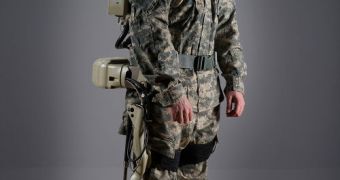The United States Army could soon have a new weapon at its disposal, the first in a new generation of combat equipment meant to give warfighters an edge over their enemies. The Hulc robotic exoskeleton has just entered a testing phase at a military research center.
This series of biomechanical assessments is aimed at understanding how to fully exploit the capabilities that the new device provide. Hulc is meant to make it easier for soldiers to carry a lot more gear then they are usually given.
HULC is a completely untethered, hydraulic-powered anthropomorphic exoskeleton. Soldiers who wear it can easily carry more than 200 pounds (nearly 91 kilograms) for extended periods of time.
The augmentation device works over all types of terrains. The entire weight of the material it carries, as well as some of its own weight, is transmitted directly to the ground via sturdy, flexible titanium legs.
What sets it apart from other systems of this type is the fact that it does not feature a joystick, or similar control mechanism. Rather, the suit itself senses what the warfighter is trying to do, and triggers the electronic commands needed to perform that specific action.
“An onboard micro-computer ensures the exoskeleton moves in concert with the individual. Its modularity allows for major components to be swapped out in the field,” a Lockheed press release says.
At this point, test models of the Hulc exoskeleton are deployed at the US Army Natick Soldier Research, Development and Engineering Center, in Natick, Massachusetts. The feedback soldiers here will provide will be used by Lockheed engineers to improve the overall design.
“Biomechanical testing will measure changes in energy expended by users, assessing how quickly individuals acclimate to the system and whether there is a reduction in metabolic cost,” the Lockheed statement indicates.
“Testing will also determine if there is an improvement in metabolic efficiency as measured by oxygen consumption per unit total mass, when wearing the ruggedized HULC as compared to not wearing the device under identical load, speed, grade and duration conditions,” the document adds.
“Our latest generation of the HULC design provides unmatched flexibility, strength and endurance. It will enable soldiers to do things they cannot do today, while helping to protect them from musculoskeletal injuries,” explains Jim Ni.
The expert holds an appointment as the HULC program manager at the Lockheed Martin Missiles and Fire Control division. After tests at Natick are concluded, an overhauled version of the exoskeleton will be sent to simulated operations theaters, for real-life testing.

 14 DAY TRIAL //
14 DAY TRIAL //